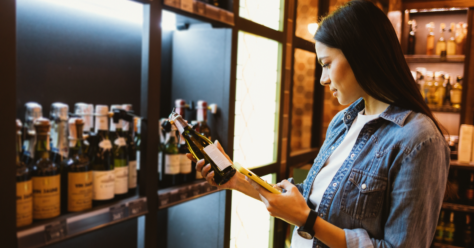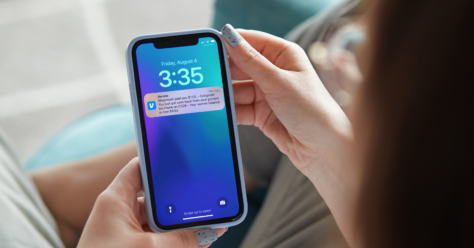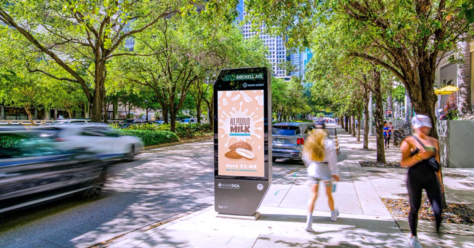Bring Campaigns to Life in Today's Digital Landscape
While digital technologies in the grocery-retail industry have been expanding for years, the rate of digital growth was greatly accelerated during the first months of the pandemic.
How we define successful social media content has evolved, new platforms have made their entrance onto the scene, out-of-home (OOH) advertising has grown to include programmatic solutions, ads and promotions have become more personalized and the purchasing process has adapted to include more eCommerce, delivery and in-store pickup options.
Continue reading to discover the many ways to bring campaigns to life in this new digital landscape.

Connecting with Consumers through Social Media
Instead of newly developed apps taking time away from other platforms, it seems as though people have made more room for social media—especially over the course of the pandemic.
On average, people in the US spent 65 minutes per day on social media in 2020, up from 54 minutes per day in 2019 and 56 minutes in 2018. Furthermore, TikTok alone experienced an 85.3% growth rate of US users in 2020. Social media and influencers have become pathways for brands to connect digitally with consumers, a trend likely to continue into the future.
Influencers have been a hot topic for years, but with people spending more time at home during the pandemic, consumers are turning to online content creators on new platforms like TikTok for advice and entertainment even more.
Successful influencers are able to form strong online communities and are often regarded as experts in their field and great sources for advice. Brands reach out to influencers of all levels to trial, discuss or endorse their products. A reference from an influencer can develop into broader awareness and proof to consumers that a product is worth trying.
Word of mouth is an incredibly powerful and trusted method for people to learn about new products and services from friends and family. In the current digital landscape, word of mouth has translated to the influencer community as people feel close and connected to these individuals. Not surprisingly, influencer marketing has quickly caught the attention of brands as an opportunity to expose relevant audiences to their product offerings through personalities consumers trust.



Video Marketing Is Reshaping the Landscape
We’ve all heard the saying, “If a picture is worth a thousand words, then a video is worth a million.” Video is a great way to quickly capture consumers’ attention on social app stories, newsfeeds and especially on fast-growing, video-centric apps like TikTok.
A short-form video social media platform, TikTok surged in popularity during the pandemic with its refined algorithm that delivers curated content feeds around each user’s interests. Not only does TikTok boast a billion active monthly users around the world, its success has prompted other social apps like Instagram to create similar short-form video features of their own.
The growth of TikTok and its impact on other social media services present dynamic opportunities for brands to share their products through influencers, ads and more.
Though TikTok was already well established before the pandemic, app usage grew during the pandemic as social distancing restrictions pushed people to spend more time at home and to rely on their phones more heavily for entertainment, advice and creative release.
TikTok and other video apps have become engaging, enjoyable and beneficial ways to connect with consumers in any environment in today’s digital landscape.



Digital Out-of-Home Bridges the Digital and Physical Worlds
OOH ads are a traditional way to connect with consumers when they’re out and about, but this tried-and-true form of advertising has evolved to include not only billboards but also digital screens with measurement capabilities. Ads can be strategically placed in malls, gyms, doctors’ offices and grocery stores where purchasing intent is at its highest. Digital out-of-home (DOOH) has become an incredibly useful tool that meshes the physical and digital worlds while fitting into the omnichannel experience.
Along with the capability to blend seamlessly into the omnichannel journey, DOOH advertising has become increasingly agile in its own right. DOOH allows retailers to deliver relevant, real-time messaging to shoppers during crucial moments and measure the impact of these messages with foot traffic analyses, attributable sales, return on ad spend and level of brand awareness.
Giving DOOH even greater versatility, programmatic DOOH messaging can quickly adapt in response to shifting circumstances—this is crucial as shopper behavior continuously evolves post-pandemic. DOOH has been able to display its agility and adaptability to offer high-intent shoppers the right messages at the right time to foster deeper, more meaningful connections. As the shopping landscape continues to change, DOOH will be a crucial tool in attracting consumers at scale and forming relationships with shoppers during their time in-store.



The Power of Personalized Experiences and Digital Trust
As ad platforms and web browsers shift away from cookies as a means to collect and track consumer data, brands can still use data to understand and connect with their audiences. One way for brands and retailers to leverage a data-backed strategy is by engaging consumers in a more personalized way through a larger omnichannel approach.
Data can provide brands and retailers with a clear picture of who their customers are, what they want and the specific products and categories they care about. In order to gather meaningful first-party data from shoppers, brands must present value to shoppers (through promotions, for example) so they see a reason to exchange their information. Then, brands can leverage the power of omnichannel strategies to more deeply and accurately target shoppers with intelligent campaigns that resonate with them.
Now in the process of being phased out, third-party cookies leave trails for brands to follow consumers through their online journey to gain insight into the websites they visit, their interests and more. This data is then used by brands to create targeted campaigns for the most relevant audiences. As privacy concerns have spurred changes in how Apple, Google and others collect data, conversations about trust and value have risen to the forefront.
First- and second-party data, which companies collect directly from their audiences, offer brands a fresh opportunity to connect closely with consumers, build trust and create more personalized experiences and value for them.



The Rise of Digital Coupons
The coupon industry has been shifting from print to digital for many years, but as with many other digital strategies, COVID-19 rapidly accelerated the adoption of online promotions as more consumers moved to eCommerce and sought value throughout the pandemic.
Coupons were once an exclusively print medium, but the way consumers look for value has morphed over the years. Shoppers now dually use both online and in-person grocery shopping, which has led to the decline of the printed free-standing insert (FSI) distributed by retailers.
In the current digital landscape, online coupon activations have increased by double digits since 2014, with a compound average growth rate of 55% year over year. Also, for the first time ever in 2020, the share of redemptions of digital coupons (29%) outpaced redemptions of the most common type of paper coupons (27%).



All in all, digital promotions offer personalization, flexibility and more means of measurement—which allows brands to strategically deliver value at scale and target consumers more effectively and efficiently.



eCommerce Boom, Expectations and Opportunities
eCommerce solutions have been available to consumer for years, but pandemic changes dramatically expedited and increased the adoption of online purchasing by consumers—whether it be through delivery; buy and pickup options; or third-party services like Instacart, Uber Eats and more.
Though many shoppers moved to eCommerce during the pandemic to limit their contact with others, consumers are now increasingly relying on these services out of convenience. Once shoppers were onboarded and gained comfort using the new platforms, many incorporated eCommerce into their everyday routines.
While many major retailers had eCommerce platforms prior to the pandemic, increased demand raised the expectations for retailers to offer functionality that could not only handle increased online traffic and orders but also fit seamlessly into consumers’ omnichannel experience.
eCommerce usage has created a significant opportunity for retailers to better understand their consumers and offer them more personalized experiences and promotions. It also allows for access to their shoppers not only when inside the store, but anytime.
We hope these facets of the digital experience spark interesting and inspiring ideas for your upcoming campaigns. For more information on how you can incorporate Quotient’s digital offerings into your company’s omnichannel approach, contact us at communications@quotient.com.



